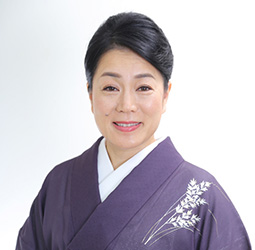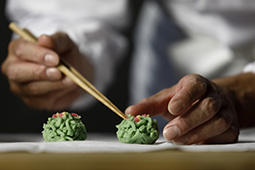September 2022
- English
- 日本語
Traditional Kyoto Sweets of Autumn

Autumn namagashi (fresh sweets) including (top left) Kure no aki (meaning late autumn) and (second from left at top) migratory wild geese 
Oval-shaped tsukimi dango (moon-viewing rice dumplings)

Momiji (maple) namagashi (fresh sweets) 
Tamaru Miyuki, proprietress of Sasaya Iori 
A confectioner making namagashi (fresh sweets)

Long-established confectionery maker Sasaya Iori continues to produce wagashi (Japanese sweets) in colors that evoke the Kyoto seasons

Kyogashi, or Kyoto sweets, are renowned as a wagashi (Japanese sweets) with a long tradition in Kyoto.
Since its founding in Kyoto in 1716, Sasaya Iori has been receiving orders from and producing seasonal Kyoto sweets for the Old Imperial Palace (the present-day Kyoto Imperial Palace), Buddhist temples, Shinto shrines, and heads of tea schools.
“Kyoto’s confectioners would test their skills against each other’s, aiming to become the official purveyors to the Imperial Court and large temples and shrinesi and improving the quality of their sweets,” explains Tamaru Miyuki, the proprietress of Sasaya Iori.
She goes on, “Kyoto is the birthplace of the tea ceremony, which continues to flourish here. The quest to produce sweets that are appropriate for serving at the tea ceremony led confectioners to develop aesthetic sensibilities unique to Kyoto sweets.”

Sasaya Iori produces namagashi (fresh sweets) to be served at tea ceremonies in autumn with motifs of gingko and momiji (maple) autumn leaves and migratory wild geese. Namagashi are beautiful hand-crafted confections made from white kidney bean paste, white azuki bean paste, or other sweet bean paste, which are displayed on store shelves only slightly ahead of the autumn season. Autumn leaf namagashi, for example, are best savored when the colors of the trees in the mountains begin to change and arouse anticipation for the autumn color to come. It is the Kyoto aesthetic of miyabi (refined and graceful).
In September in Japan, on the night of the most beautiful moon of the year, the chushu no meigetsu (mid-autumn or harvest moon), the custom is to offer and consume tsukimi dango (moon-viewing rice dumplings) made of rice flour or other flour to give thanks for a bountiful autumn harvest. While tsukimi dango are typically spherical in shape, the preference in Kyoto and at Sasaya Iori is for oval dumplings shaped like satoimo (a type of taro). This dates back to ancient times, when offerings were not dumplings but freshly harvested satoimo.

When the leaves begin to change color, Sasaya Iori produces a namagashi called Kure no aki (late autumn), which is reddish-brown tinged with yellow and orange. The sweet is abstract in form, but the name Kure no aki evokes the image of mountains in late autumn, as the leaf-viewing season comes to an end. In this way, names are given to each namagashi that gives physical form to the season, and there is pleasure in seeing and feeling design that evokes the season.
Says Tamaru, “Each traditional Japanese sweet contains a prayer, a wish, or a message. We see our work as, through Kyoto sweets, conveying the changes of the seasons, and also those things that Japanese people have cherished.”

Thus, we may savor these refined Kyoto sweets that bring color to autumn, while feeling in their colors and shapes the thoughts of their confectioner makers.
* The supplying of goods to the Imperial Court or government offices. Also, a merchant who supplies such goods.

